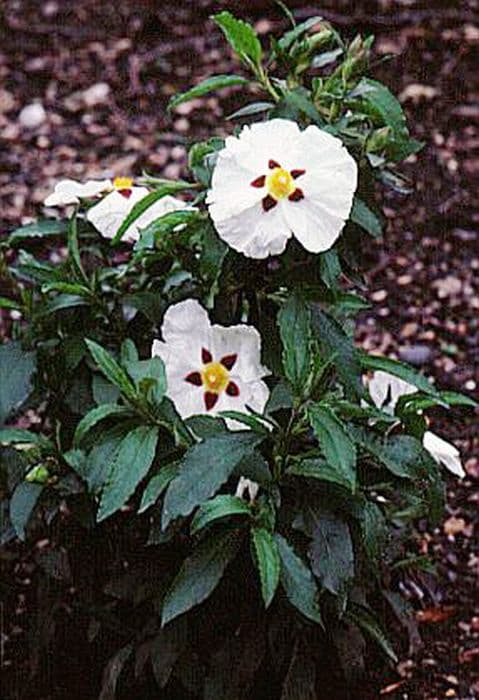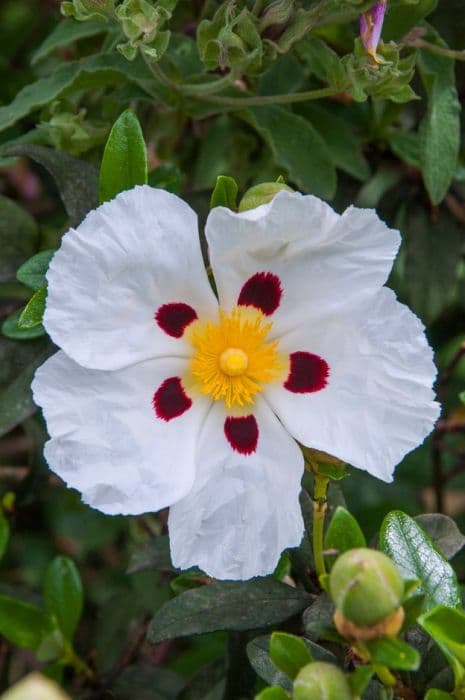Rock Rose Helianthemum 'Highdown Apricot'

ABOUT
Helianthemum 'Highdown Apricot', commonly known as Rock Rose, is a charming, low-growing plant notable for its showy flowers and foliage. The flowers have a delicate, papery texture and display a warm apricot color, occasionally with a faint blush or darker tones at the center. They typically exhibit five petals arranged in a simple, open formation that resembles a small wild rose, with a spray of prominent yellow stamens at the heart of the bloom, which add a striking contrast to the soft color of the petals. The foliage of the Rock Rose is equally attractive, consisting of small, narrow leaves that are a grayish-green hue, providing a lovely backdrop that accentuates the brightness of the flowers. The leaves often have a slightly furry or downy texture, adding to the plant's overall soft and inviting appearance. The Rock Rose displays a low and spreading habit, with branches that cascade gently and create a mat-like effect, making it an ideal choice for ground cover or rockeries where it can spill attractively over edges. Its flowering season typically brings a profusion of blooms, covering the plant in a burst of its characteristic apricot hues and providing a remarkably cheerful and vibrant aspect to gardens or landscapes.
About this plant
 Names
NamesFamily
Cistaceae.
Synonyms
Rock Rose, Sunrose, Rushrose, Frostweed.
Common names
Helianthemum 'Highdown Apricot'.
 Toxicity
ToxicityTo humans
The Rock Rose 'Highdown Apricot' is not commonly known to be toxic to humans. There are no well-documented symptoms of poisoning from this plant, as it is generally considered safe. However, as with any plant, individual allergic reactions or sensitivities may occur, so it's always best to handle plants with care and avoid ingesting plant material.
To pets
The Rock Rose 'Highdown Apricot' is not known to be toxic to pets. It is not listed among the common toxic plants for animals like dogs and cats. Therefore, pets that ingest this plant should not exhibit symptoms of poisoning solely from the plant. However, keeping an eye on your pets and preventing them from eating large amounts of any non-food plants is always a good practice to avoid any potential stomach upset or unforeseen allergic reactions.
 Characteristics
CharacteristicsLife cycle
Perennials
Foliage type
Evergreen
Color of leaves
Green
Flower color
Apricot
Height
1 foot (30 cm)
Spread
2 feet (60 cm)
Plant type
Shrub
Hardiness zones
Varies
Native area
Mediterranean
Benefits
 General Benefits
General Benefits- Attracts Pollinators: The plant produces flowers that are attractive to bees and butterflies, enhancing pollination.
- Drought Tolerant: Once established, the plant has low water requirements and can survive periods of drought, making it ideal for water-wise gardens.
- Low Maintenance: Requires minimal care beyond occasional pruning and is resilient to most pests and diseases.
- Landscape Design Versatility: Can be used in a variety of garden styles, including rockeries, borders, and as ground cover.
- Winter Interest: Some varieties retain their evergreen foliage throughout the winter, providing color and texture in the garden during dormant months.
- Soil Adaptability: Tolerant of a range of soil types, though it prefers well-drained soils, making it adaptable to different garden conditions.
- Fast Growing: It has a relatively quick growth rate, allowing for quicker establishment and coverage in garden designs.
- Sun-loving: Thrives in full sun, making it a good choice for sunny spots where other plants might struggle.
 Medical Properties
Medical PropertiesThis plant is not used for medical purposes.
 Air-purifying Qualities
Air-purifying QualitiesThis plant is not specifically known for air purifying qualities.
 Other Uses
Other Uses- Photography prop – The Highdown Apricot's vibrant blooms can be used as a natural backdrop or a subject in macro photography to capture the intricate details and colors of the flowers.
- Artistic inspiration – Artists may use the plant as a subject for painting or drawing, capturing its apricot-colored blossoms on canvas or paper.
- Educational tool – Botany teachers can use the Highdown Apricot to show students plant growth, pollination, and the lifecycles of perennial plants.
- Natural dye – The petals of the Highdown Apricot could potentially be used to create a soft, apricot-hued dye for fabrics or crafts.
- Culinary decoration – Although not typically known for culinary uses, the flowers could serve as an attractive, organic garnish for special dishes or desserts.
- Highdown Apricot potpourri – Dried flowers can be mixed with herbs and spices to create a visually appealing and fragrant potpourri.
- Theme gardens – It can be included in color-themed gardens, such as a pastel or "sunset colors" garden, due to its apricot-colored flowers.
- Children’s garden projects – The plant can be used to teach children about gardening and nurturing plants, as it is an easy-to-care-for example.
- Soil erosion control – Used in the garden to help stabilize soil on slopes due to its spreading habit and ability to form ground cover.
- Green roof planting – Its hardiness and drought resistance make Highdown Apricot suitable for green roofing projects, where low maintenance and survivability are key.
Interesting Facts
 Feng Shui
Feng ShuiThe Rock Rose is not used in Feng Shui practice.
 Zodiac Sign Compitability
Zodiac Sign CompitabilityThe Rock Rose is not used in astrology practice.
 Plant Symbolism
Plant Symbolism- Endurance: Helianthemum, also known as Rock Rose or Sunrose, often symbolizes endurance due to its ability to thrive in rocky, arid environments and withstand tough conditions.
- Survival: Representing survival, the Rock Rose's persistent nature in harsh landscapes embodies the spirit of persistence and overcoming adversity.
- Resilience: The plant's propensity to bounce back after damage and its evergreen qualities make it a symbol of resilience and the ability to recover from challenges.
 Water
WaterRock Rose 'Highdown Apricot' requires moderate watering. Established plants are somewhat drought-tolerant and should be watered deeply but infrequently. In the growing season, water the plant once or twice a week, making sure the soil is allowed to dry out between waterings. Apply approximately one gallon of water per session to ensure the roots receive sufficient moisture. Reduce the frequency during winter to every two to three weeks, as the plant's water needs decrease during dormancy.
 Light
LightRock Rose 'Highdown Apricot' thrives best in full sunlight. It should be planted in a location where it can receive at least six hours of direct sunlight daily. An ideal spot would be a southern or western exposure that provides bright light to encourage abundant flowering.
 Temperature
TemperatureRock Rose 'Highdown Apricot' is hardy and can handle a temperature range from 30 to 85 degrees Fahrenheit. The ideal temperature range for this plant is between 50 and 70 degrees Fahrenheit. It can survive brief periods of colder weather but should be protected from frost to prevent damage.
 Pruning
PruningRock Rose 'Highdown Apricot' should be pruned to maintain shape and encourage denser growth. Prune lightly after flowering, typically in late spring or early summer. This will help promote new growth and prepare the plant for the next blooming season. Deadheading spent blooms can also be beneficial in extending the flowering period.
 Cleaning
CleaningAs needed
 Soil
SoilRock rose 'Highdown Apricot' thrives in well-draining, sandy or gravelly soil with a slightly acidic to neutral pH range of 6.0 to 7.5. Mix equal parts of sand, loam, and peat for the best soil composition to ensure good drainage and aeration.
 Repotting
RepottingRock rose 'Highdown Apricot' can be repotted every 2-3 years or when it outgrows its current pot. It's best to repot in early spring before new growth begins, using a well-draining soil mix.
 Humidity & Misting
Humidity & MistingRock rose 'Highdown Apricot' prefers a dry climate and will do well in average household humidity levels. It is not necessary to maintain high humidity levels for this plant; it tolerates low humidity well.
 Suitable locations
Suitable locationsIndoor
Place in a sunny spot and water sparingly.
Outdoor
Plant in a sunny location with well-draining soil.
Hardiness zone
5-8 USDA
 Life cycle
Life cycleThe Helianthemum 'Highdown Apricot', commonly known as rock rose, initiates its life cycle as a seed, requiring well-drained soil and a sunny location to germinate. Upon sprouting, the seedling stage is characterized by the development of a small rosette of leaves at the soil surface. As the plant enters the vegetative stage, it grows broader and woody at the base with numerous branches, and its gray-green leaves become more pronounced. The flowering stage follows, usually in late spring to early summer, with the rock rose producing apricot to pale orange flowers that attract pollinators. After pollination, the flowers develop into seed capsules, and once mature, the seeds are dispersed to begin a new life cycle. The plant is a short-lived perennial and may need to be replaced every few years as part of its life cycle.
 Propogation
PropogationPropogation time
Spring-Early Summer
The most popular method for propagating Helianthemum 'Highdown Apricot', commonly known as Rock Rose, involves taking semi-ripe cuttings during summer. Cuttings, typically around 3 to 4 inches (approximately 7.5 to 10 cm) long, are snipped from new growth that is starting to harden, just below a leaf node. The lower leaves are removed, and the base of the cutting may be dipped in rooting hormone to encourage root development. Cuttings are then placed in a well-draining potting mix, ensuring at least one leaf node is buried where new roots can form. The container with the cuttings should be kept in a warm, bright spot out of direct sunlight, and the soil made consistently moist until the cuttings have taken root, which usually takes several weeks.









